In a Remote Corner of Canada, One Pack of Coastal Wolves Has Evolved to Fish for Salmon, Swim Between Islands, and Survive Like No Other Wolves on Earth
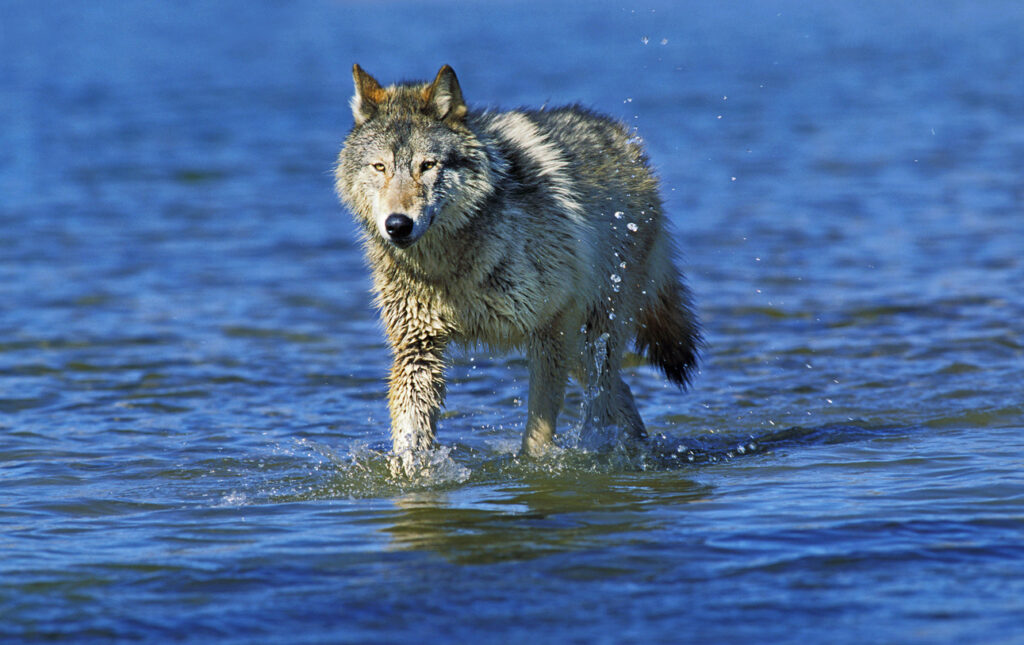
In the remote coastal corners of British Columbia’s Great Bear Rainforest, a pack of wolves has evolved in ways that defy the typical image of a wolf. These coastal wolves don’t just roam the forests; they’ve adapted to become apex predators of both land and sea. They fish for salmon, swim across icy saltwater channels, and hunt marine life, with over 75% of their diet coming from the ocean. In a place where land and sea converge, these wolves have mastered the art of survival in a way no other wolf population has.
With behaviors unlike any seen in inland wolves, these “Sea Wolves” use stealth and timing to catch fish in wild surf, diving into waves just like grizzly bears during a salmon run. Their ability to swim miles between islands and hunt in remote, roadless regions makes them nearly impossible to study. Yet, despite being one of the most elusive species, these wolves are also some of the most extraordinary examples of nature’s ability to adapt. Their unique lifestyle is a testament to the powerful survival instincts that have allowed them to thrive in one of the last pristine wildernesses on Earth.
1. These Wolves Live on the Pacific Coast of Canada
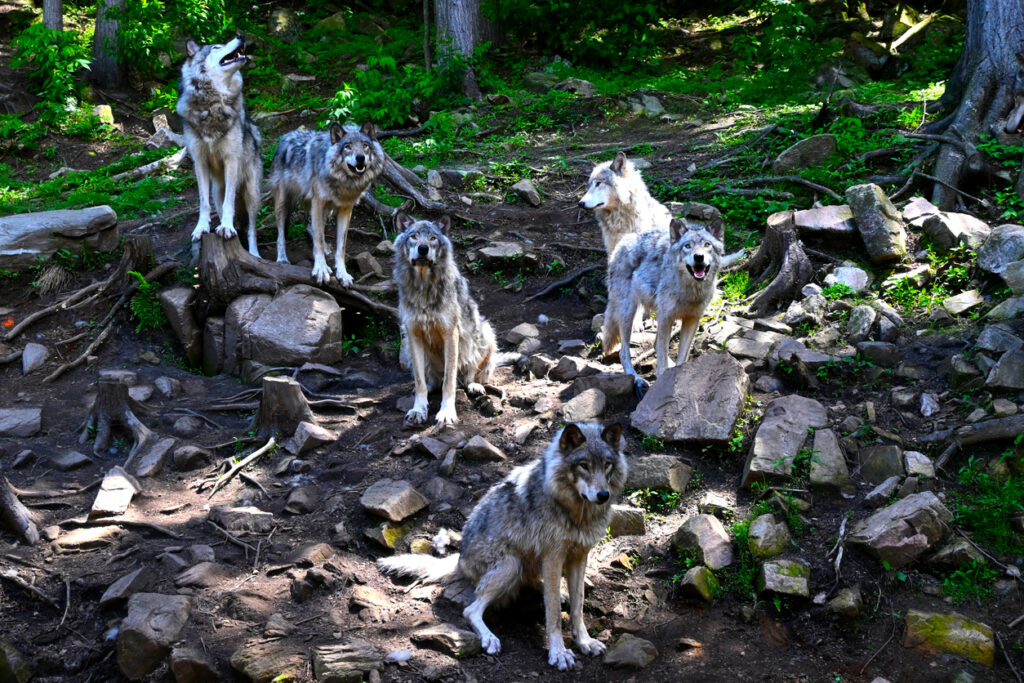
In the heart of British Columbia’s Great Bear Rainforest, a unique pack of wolves has evolved to thrive where land meets ocean. This remote, pristine wilderness spanning over 6.4 million hectares (15.8 million acres) is one of the last untouched ecosystems on Earth, providing a perfect environment for these coastal wolves. Unlike their inland relatives, these wolves have adapted to their coastal surroundings, relying heavily on the ocean for food.
Here, they’ve developed behaviors that no other wolves on the planet have, including hunting marine life and fishing for salmon. Their survival is a result of this unique blend of forest and sea, setting them apart as one of the most extraordinary examples of predator adaptation. The Great Bear Rainforest provides an ideal habitat, where the ocean and forests converge to offer abundant resources that help these wolves thrive in a way that inland packs never could.
2. They Don’t Just Eat Fish—They Catch It Themselves
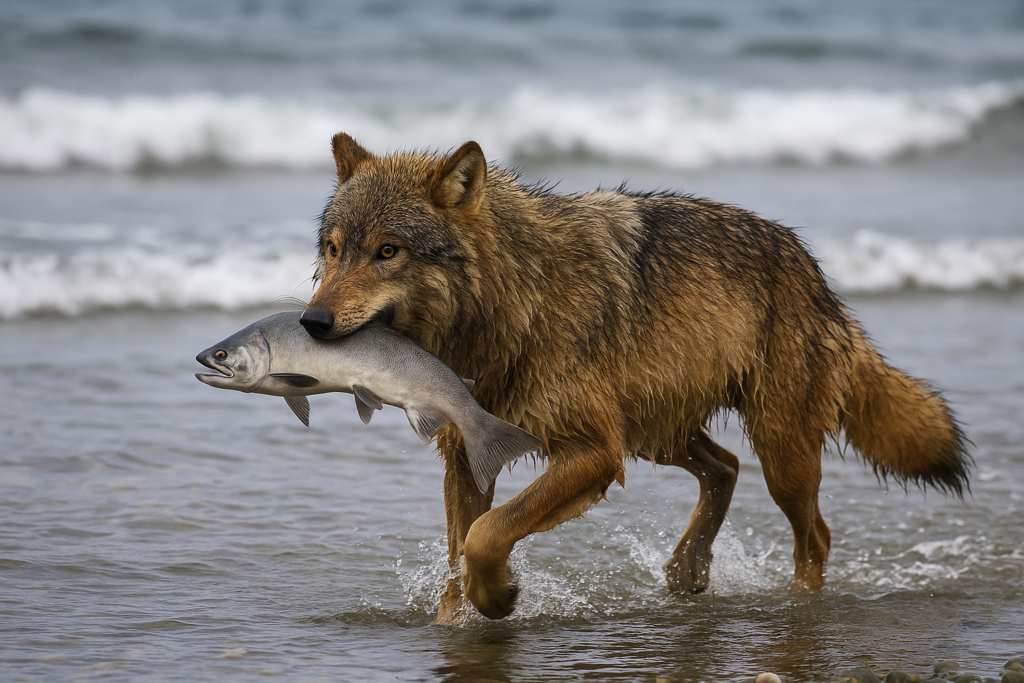
Unlike most wolves, who scavenge fish when it’s available, these coastal wolves actively hunt their prey. They wade into rushing rivers and plunge into the surf, using their jaws to snatch live salmon mid-swim. Their precision and timing in catching salmon, similar to grizzly bears during the salmon run, is a testament to their efficiency in this resource-rich coastal environment. This isn’t a random behavior but a learned skill passed down through generations, and it’s essential to their survival, making them true masters of the water.
Fishing is so central to their diet that over 75% of their food comes from marine life, including salmon, seals, and sea otters. This heavy reliance on the ocean makes their hunting tactics even more vital, providing the wolves with a steady, year-round food supply. In an environment where terrestrial prey is scarce, these wolves have developed fishing as a core survival strategy, showcasing an extraordinary example of nature’s adaptability.
3. They Swim Between Islands Like Sea Creatures
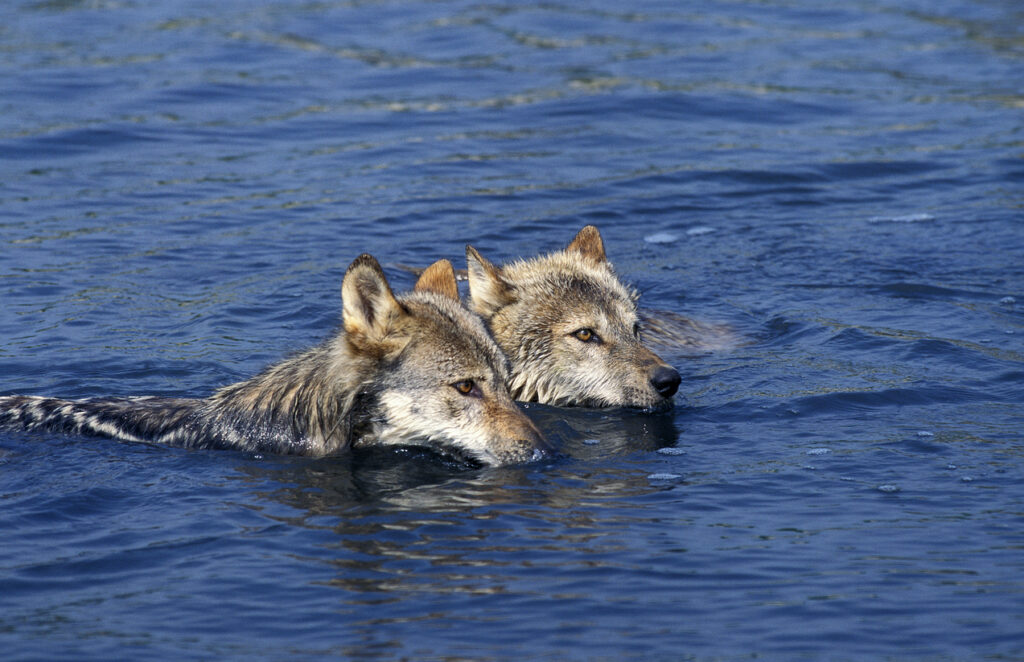
These coastal wolves are not only skilled hunters but also expert swimmers. Living in an environment filled with isolated islands, these wolves regularly swim across icy saltwater channels, covering miles to reach new hunting grounds, reunite with their pack, or explore uncharted territories. This ability to swim between islands is a rare and incredible survival skill that sets them apart from most terrestrial predators. With their lean, streamlined bodies and waterproof fur, they’ve adapted perfectly to life in the rugged coastal environment.
Their swimming ability allows them to navigate a harsh landscape where food and shelter are spread across a series of islands. The distance they cover during these swims can be up to 8 kilometers (5 miles), making it clear that these wolves are not limited to the land. Instead, they’ve become adept at using the ocean as a resource, expanding their range and access to resources in ways that most wolves cannot. It’s a truly unique adaptation that highlights just how versatile these wolves are in their challenging habitat.
4. Their Diet Is Over 75% Seafood
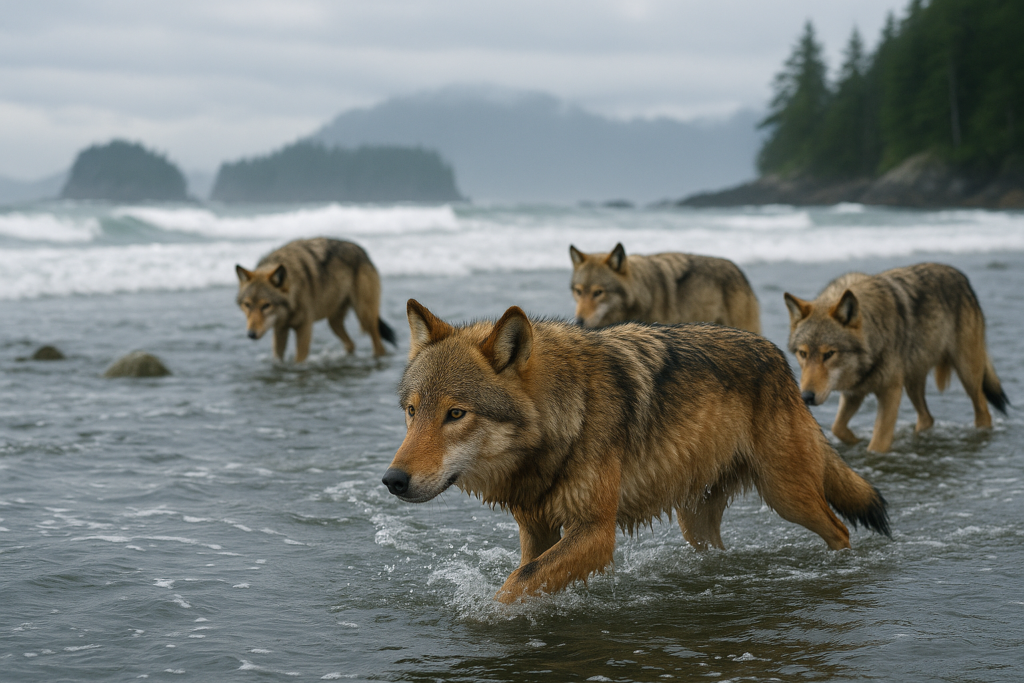
Unlike inland wolves that primarily hunt land animals, these coastal wolves rely heavily on the ocean for their food. Over 75% of their diet comes from marine life, including salmon, seals, sea otters, and even whale carcasses that wash ashore. This aquatic diet provides them with a steady food source throughout the year, particularly during the salmon runs when the rivers are teeming with fish. This reliance on seafood has enabled these wolves to thrive in an environment where land-based prey can be scarce or difficult to catch.
This unique diet not only sustains them but also contributes to their overall health, providing essential nutrients such as omega-3 fatty acids, which are vital for their strength and endurance. The coastal environment provides the perfect setting for these wolves to adapt their hunting strategies, relying on the rich marine ecosystem to meet their nutritional needs. Their survival in this coastal paradise is a direct result of their ability to integrate marine hunting into their lifestyle.
5. They’ve Been Filmed Hunting in the Surf

Thanks to hidden cameras and drones, scientists have captured incredible footage of these wolves hunting in the Surf. Using the waves as cover, they dive into the wild ocean, snatching massive fish from the water with impressive precision. The footage shows these wolves using stealth and perfect timing to catch their prey, much like grizzly bears during salmon runs. Their ability to adapt to such an environment and successfully hunt in the Surf is a fascinating testament to their evolutionary versatility.
These filmed hunts have provided researchers with rare insights into their behavior, confirming that coastal wolves are not just survivors; they’re apex predators of both land and sea. The footage also showcases their ability to use the rhythm of the Surf to their advantage, showing that these wolves have mastered the art of fishing in the most challenging conditions. It’s a unique skill set that places them in a category all their own among land predators.
6. Scientists Call Them “Sea Wolves”
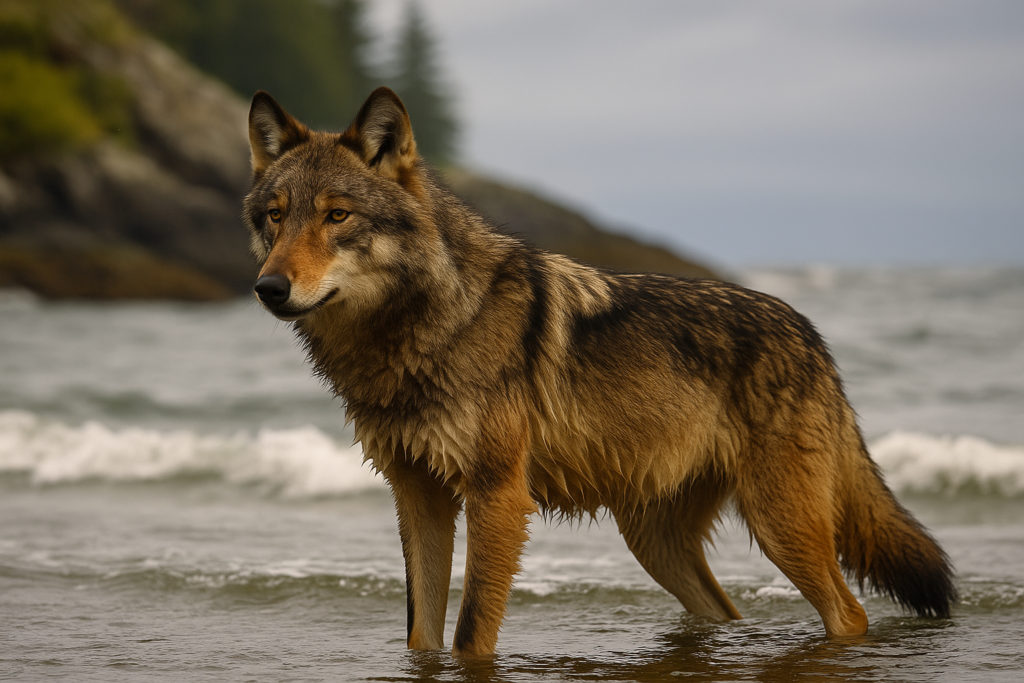
Scientists have given these remarkable coastal wolves the nickname “Sea Wolves” due to their extraordinary ability to thrive in both forested and marine environments. Genetically distinct from inland wolves, these coastal predators exhibit unique physical traits, slightly smaller builds, specialized fur patterns, and an enhanced ability to hunt marine life. This adaptation allows them to dominate their coastal habitats, making them one of the most fascinating examples of predator evolution. These traits have been passed down through generations, and their aquatic hunting techniques are a direct result of the wolves’ long-standing relationship with the ocean.
The term “Sea Wolves” reflects their remarkable ability to merge land and sea-based hunting strategies. By relying on both terrestrial prey and marine resources, these wolves have carved out an entirely new ecological niche. Their unique skill set and specialized behaviors have made them a key subject of study as researchers continue to marvel at how these wolves have evolved to adapt to such extreme conditions. As apex predators in both the forest and the ocean, they truly embody the power of nature’s adaptability.
7. They’re Incredibly Hard to Study

Studying these coastal wolves is no easy feat. Living in remote, roadless areas of the Great Bear Rainforest, they are incredibly difficult to track and observe. Researchers have to rely on DNA samples from scat, camera traps, and boat-based observations to gather information about the pack’s behavior and movements. The wolves’ isolation, combined with their vast territory, makes it challenging to monitor their habits directly. Even with modern technology, studying them in their natural habitat remains a complex and elusive task.
Despite these challenges, scientists continue to learn more about these fascinating creatures. With the help of hidden cameras and drones, researchers have been able to capture rare footage of the wolves hunting in the surf and swimming between islands. These innovative techniques are providing valuable insights into the wolves’ behavior and survival strategies, helping to piece together the puzzle of how these wolves thrive in such a challenging environment.
8. Their Behavior May Go Back Thousands of Years

Some First Nations oral histories describe wolves that fished and swam the seas long before modern researchers confirmed these behaviors. These ancient stories suggest that the behavior of coastal wolves might not be as new as it seems. For generations, indigenous cultures have spoken of wolves that adapted to the coastal environment, hunting marine life, and swimming between islands. These traditions offer a fascinating glimpse into how early humans may have recognized the wolves’ unique survival strategies long before scientists could document them.
This connection between oral history and modern scientific findings raises the possibility that the wolves’ fishing and swimming behaviors have existed for thousands of years. These ancient stories suggest a profound, enduring connection between wolves and the sea, which may have shaped the evolution of these animals over time. The discovery of these behaviors by scientists adds another layer to the rich cultural and ecological history of the coastal wolves, illustrating how deeply intertwined nature and human experience can be.
9. They’re Threatened by Logging and Fish Farms
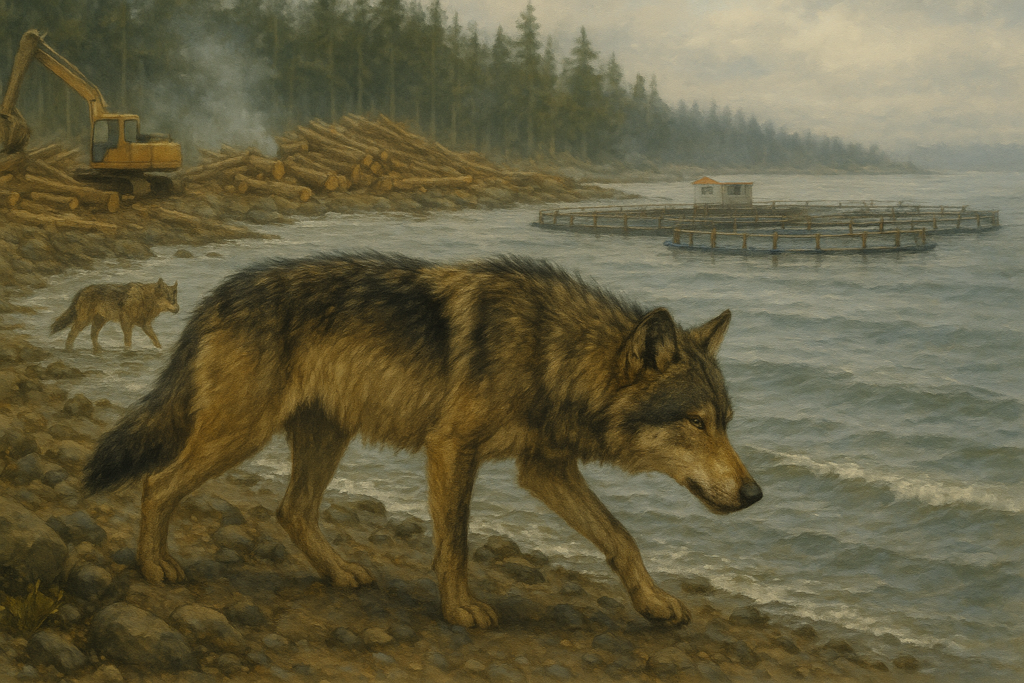
Despite their incredible adaptations, these coastal wolves face significant threats from human activities. Logging in the Great Bear Rainforest and the expansion of fish farms are causing severe damage to their habitat. The destruction of coastal forests, which provide shelter and hunting grounds, and the loss of salmon spawning areas, which are crucial to their diet, are both major concerns for the wolves’ survival. As these human industries encroach on their territory, the very ecosystems that sustain them are being undermined, putting their future at risk.
In addition to habitat destruction, industrial noise and the decline of fish stocks are further challenges. Fish farms, in particular, disrupt the delicate balance of the coastal ecosystem, impacting the health of wild fish populations. These environmental pressures are making it increasingly difficult for wolves to thrive in the same way they have for centuries. To ensure the survival of these remarkable animals, conservation efforts must address the long-term impacts of logging, fish farms, and other human activities that threaten their habitat.
10. They’re Proof That Wolves Can Adapt in Amazing Ways
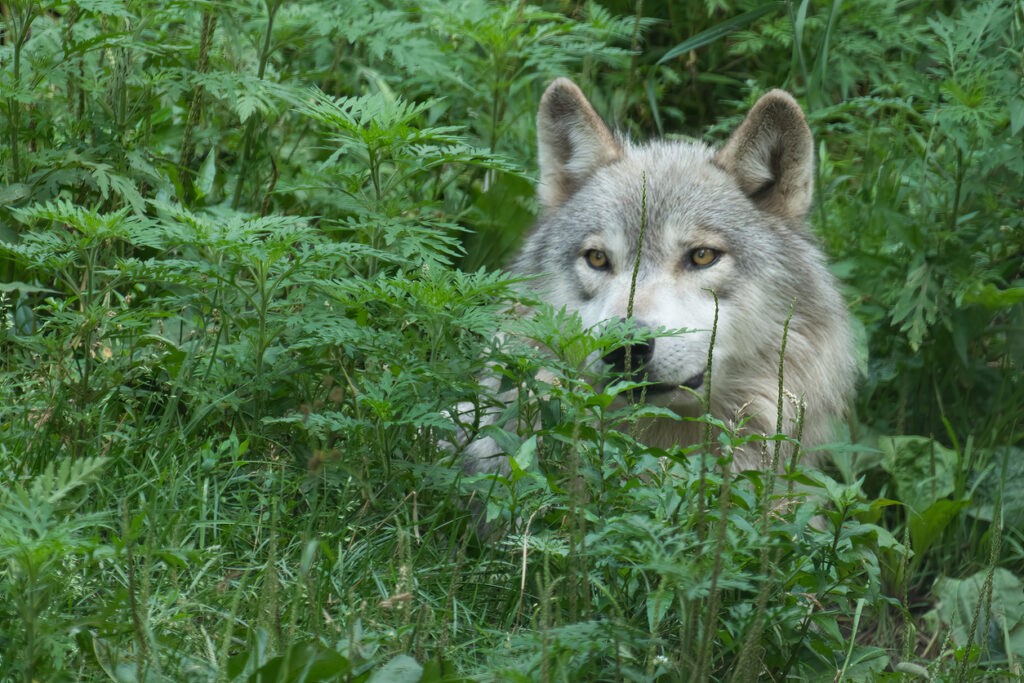
The coastal wolves of British Columbia are living proof of nature’s incredible adaptability. From fishing in rushing rivers to swimming across icy channels between islands, these wolves have evolved to thrive in one of the most challenging environments on Earth. Their ability to hunt and survive in such diverse conditions both on land and in the ocean shows that wolves are capable of far more than we typically associate with them. These wolves have defied expectations, using the sea and forests to their advantage in ways that most land predators could never imagine.
Their success is a testament to the adaptability of species, which can evolve to meet the demands of their environment. The Great Bear Rainforest, with its untouched ecosystems and abundant resources, has shaped these wolves into extraordinary predators. Their ability to hunt, swim, and survive in both forest and oceanic settings makes them a remarkable example of evolutionary success. As the world changes, the story of these wolves serves as a reminder of how animals can adapt and thrive, even in the most unlikely places.
The Future of the Sea Wolves: A Call for Conservation
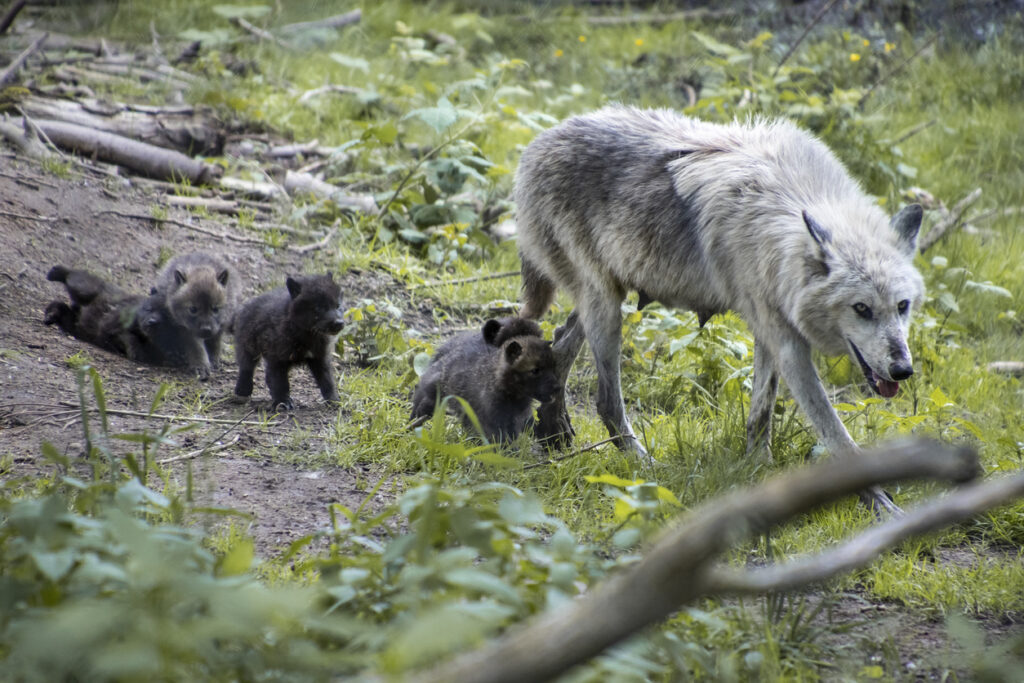
These incredible wolves are a living testament to the power of adaptation. As apex predators of both land and sea, they’ve evolved in ways that most animals could never dream of. However, with threats such as logging, fish farms, and climate change looming, their future is far from guaranteed. Protecting their habitat is crucial not only for their survival but for preserving one of nature’s most extraordinary stories. The coastal wolves of British Columbia remind us that the wild is full of mysteries waiting to be discovered and that, even in the most remote corners of the world, life finds a way to thrive in the most unexpected forms.
This story, 10 Wild Facts About the Wolves That Hunt Like Grizzlies was first published on dailyfetch.net.


